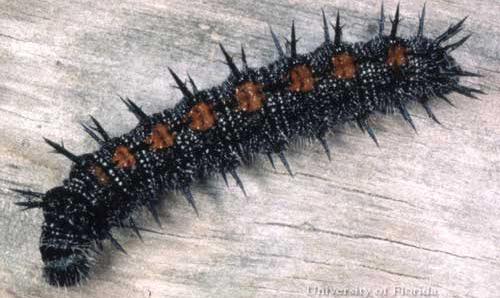Nature is a wonder and studies have shown that being surrounded by it is good for mental health. As a result, many people enjoy gardening. It soothes the soul and yields beautiful plants or delicious crops. However, one woman panicked to find Nymphalis Antiopa eggs in her garden. Luckily, the internet had some helpful insight.
Nymphalis Antiopa are Pollinators

Keeping pets away from the garden is a task that has daunted farmers and gardeners for ages. While some store-bought solutions are effective, insects like ladybugs and praying mantes are valuable in aiding a healthy and thriving garden. Meanwhile, insects like bees and butterflies make great pollinators. Interestingly, the Nymphalis Antiopa, also known as the mourning cloak, lays eggs that have caused some alarm among gardeners.
Nymphalis Antiopa Lay Fascinating Eggs

The Nymphalis Antiopa lays eggs with light yellow or green geometric shapes that become darker, eventually turning black, just before the Nymphalis Antiopa hatch. Sadly, the egg clusters’ geometric shapes can make the leaves appear infected or have a disease.
Halloween Themed Caterpillars

When left alone the Nymphalis Antiopa egg clusters hatch into black caterpillars with spikes and white and orange spots. However, they feed on the host plants, seemingly causing the plant harm.
Contributors to Biodiversity

In contrast, they benefit the plant by feeding on rotting fruits and “enhancing the decomposition process.” Moreover, the stunning butterfly aids pollination and is an important factor in the diet of other bugs like spiders. Overall, it’s a major contributor to “local biodiversity.”
Adult Nymphalis Antiopa Have Colorful Displays

Nymphalis Antiopa adult butterflies have a wingspan of around 3 inches. Their wings vary, boasting an array of colors. The upper part of the wing is maroon with a black band. Meanwhile, the lower part of the wings displays “a series of powder blue spots and a yellow marginal band.” Lastly, the “ventral side” is black with a white or yellow band.
Staying Warm in Winter

The Nymphalis Antiopa lives in North America, from Alaska to parts of South America, including Venezuela. During the winter months, adult butterflies are seen soaking up the sun, feeding on sap, and prefer warmer climates. Interestingly, adult butterflies have a really cool and complex way of protecting themselves from the cold. They have “antifreeze” chemicals called glycerols in their blood to prevent them from freezing. These beautiful and fascinating butterflies also use “isometric shivering” to help raise their body temperatures before coming out to feed.
Nymphalis Antiopa Have Favorite Trees

They nest and feed on various host plants including favorites like the weeping willow, oak, and elms. Once hatched, the Nymphalis Antiopa caterpillars live in a “communal web” and feed together until they pupate and become young adults. These butterflies typically emerge in June or July. After a short feeding stint, they’ll “hibernate” until fall to feed again then go into hibernation or migrate south.
Healthy Garden Tips

While offputting in appearance, the Nymphalis Antiopa eggs hatch to become beautifully dark-colored butterflies that can, like other insects, help maintain a thriving ecosystem in your garden. However, they can also cause some damage so knowing which plants are invasive to where you live, and which plants grow well, will also help aid a healthy garden. Additionally, soil quality and access to water and sunlight play major roles. Essentially, a healthy garden requires a well-balanced system, and doing some research can help to ensure that.
You may find Nymphalis Antiopa eggs in your garden and want to get rid of them. It’s okay to relocate them to another tree or shrub, gently. However, it’s not a good idea to kill them as they play a helpful function in a thriving ecosystem.















Leave a Reply